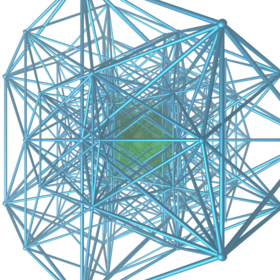In four-dimensional Euclidean geometry, the 16-cell honeycomb is one of the three regular space-filling tessellations (or honeycombs), represented by Schläfli symbol {3,3,4,3}, and constructed by a 4-dimensional packing of 16-cell facets, three around every face.
| 16-cell honeycomb |
|---|

Perspective projection: the first layer of adjacent 16-cell facets. |
| Type | Regular 4-honeycomb
Uniform 4-honeycomb |
| Family | Alternated hypercube honeycomb |
| Schläfli symbol | {3,3,4,3} |
| Coxeter diagrams |         
       = =         
     = =       
      |
| 4-face type | {3,3,4}  |
| Cell type | {3,3}  |
| Face type | {3} |
| Edge figure | cube |
| Vertex figure | 
24-cell |
| Coxeter group |  = [3,3,4,3] = [3,3,4,3] |
| Dual | {3,4,3,3} |
| Properties | vertex-transitive, edge-transitive, face-transitive, cell-transitive, 4-face-transitive |
Its dual is the 24-cell honeycomb. Its vertex figure is a 24-cell. The vertex arrangement is called the B4, D4, or F4 lattice.[1][2]
- Hexadecachoric tetracomb/honeycomb
- Demitesseractic tetracomb/honeycomb
Vertices can be placed at all integer coordinates (i,j,k,l), such that the sum of the coordinates is even.
The vertex arrangement of the 16-cell honeycomb is called the D4 lattice or F4 lattice.[2] The vertices of this lattice are the centers of the 3-spheres in the densest known packing of equal spheres in 4-space;[3] its kissing number is 24, which is also the same as the kissing number in R4, as proved by Oleg Musin in 2003.[4][5]
The related D+
4 lattice (also called D2
4) can be constructed by the union of two D4 lattices, and is identical to the C4 lattice:[6]




 ∪
∪ 



 =
= 





 =
= 








The kissing number for D+
4 is 23 = 8, (2n – 1 for n < 8, 240 for n = 8, and 2n(n – 1) for n > 8).[7]
The related D*
4 lattice (also called D4
4 and C2
4) can be constructed by the union of all four D4 lattices, but it is identical to the D4 lattice: It is also the 4-dimensional body centered cubic, the union of two 4-cube honeycombs in dual positions.[8]




 ∪
∪ 



 ∪
∪ 



 ∪
∪ 



 =
= 



 =
= 



 ∪
∪ 



 .
.
The kissing number of the D*
4 lattice (and D4 lattice) is 24[9] and its Voronoi tessellation is a 24-cell honeycomb, 



 , containing all rectified 16-cells (24-cell) Voronoi cells,
, containing all rectified 16-cells (24-cell) Voronoi cells, 





 or
or 





 .[10]
.[10]
There are three different symmetry constructions of this tessellation. Each symmetry can be represented by different arrangements of colored 16-cell facets.
More information  ,
,  ...
...
| Coxeter group |
Schläfli symbol |
Coxeter diagram |
Vertex figure
Symmetry |
Facets/verf |
|---|
 = [3,3,4,3] = [3,3,4,3] | {3,3,4,3} |          |       
[3,4,3], order 1152 | 24: 16-cell |
 = [31,1,3,4] = [31,1,3,4] | = h{4,3,3,4} |        = =          |       
[3,3,4], order 384 | 16+8: 16-cell |
 = [31,1,1,1] = [31,1,1,1] | {3,31,1,1}
= h{4,3,31,1} |      = =        |     
[31,1,1], order 192 | 8+8+8: 16-cell |
2×½ = [[(4,3,3,4,2+)]] = [[(4,3,3,4,2+)]] | ht0,4{4,3,3,4} |       | |
8+4+4: 4-demicube
8: 16-cell |
Close
It is related to the regular hyperbolic 5-space 5-orthoplex honeycomb, {3,3,3,4,3}, with 5-orthoplex facets, the regular 4-polytope 24-cell, {3,4,3} with octahedral (3-orthoplex) cell, and cube {4,3}, with (2-orthoplex) square faces.
It has a 2-dimensional analogue, {3,6}, and as an alternated form (the demitesseractic honeycomb, h{4,3,3,4}) it is related to the alternated cubic honeycomb.
This honeycomb is one of 20 uniform honeycombs constructed by the  Coxeter group, all but 3 repeated in other families by extended symmetry, seen in the graph symmetry of rings in the Coxeter–Dynkin diagrams. The 20 permutations are listed with its highest extended symmetry relation:
Coxeter group, all but 3 repeated in other families by extended symmetry, seen in the graph symmetry of rings in the Coxeter–Dynkin diagrams. The 20 permutations are listed with its highest extended symmetry relation:
More information  ,
,  ...
...
| D5 honeycombs |
|---|
Extended
symmetry |
Extended
diagram |
Extended
group |
Honeycombs |
| [31,1,3,31,1] |
       |
 |
       |
<[31,1,3,31,1]>
↔ [31,1,3,3,4] |
      
↔          |
 ×21 = ×21 =  |
       , ,        , ,        , ,       
       , ,        , ,        , ,       
|
| [[31,1,3,31,1]] |
       |
 ×22 ×22 |
       , ,        |
<2[31,1,3,31,1]>
↔ [4,3,3,3,4] |
      
↔            |
 ×41 = ×41 =  |
       , ,        , ,        , ,        , ,        , ,        |
[<2[31,1,3,31,1]>]
↔ [[4,3,3,3,4]] |
      
↔            |
 ×8 = ×8 =  ×2 ×2 |
       , ,        , ,        |
Close
Regular and uniform honeycombs in 4-space:
Conway and Sloane, Sphere packings, lattices, and groups, 1.4 n-dimensional packings, p.9
Conway and Sloane, Sphere packings, lattices, and groups, 1.5 Sphere packing problem summary of results, p. 12
Conway and Sloane, Sphere packings, lattices, and groups, 7.3 The packing D3+, p.119
Conway and Sloane, Sphere packings, lattices, and groups, p. 119
Conway and Sloane, Sphere packings, lattices, and groups, 7.4 The dual lattice D3*, p.120
Conway and Sloane, Sphere packings, lattices, and groups, p. 120
Conway and Sloane, Sphere packings, lattices, and groups, p. 466
- Coxeter, H.S.M. Regular Polytopes, (3rd edition, 1973), Dover edition, ISBN 0-486-61480-8
- pp. 154–156: Partial truncation or alternation, represented by h prefix: h{4,4} = {4,4}; h{4,3,4} = {31,1,4}, h{4,3,3,4} = {3,3,4,3}, ...
- Kaleidoscopes: Selected Writings of H.S.M. Coxeter, edited by F. Arthur Sherk, Peter McMullen, Anthony C. Thompson, Asia Ivic Weiss, Wiley-Interscience Publication, 1995, ISBN 978-0-471-01003-6
- (Paper 24) H.S.M. Coxeter, Regular and Semi-Regular Polytopes III, [Math. Zeit. 200 (1988) 3-45]
- George Olshevsky, Uniform Panoploid Tetracombs, Manuscript (2006) (Complete list of 11 convex uniform tilings, 28 convex uniform honeycombs, and 143 convex uniform tetracombs)
- Klitzing, Richard. "4D Euclidean tesselations". x3o3o4o3o - hext - O104
- Conway JH, Sloane NJH (1998). Sphere Packings, Lattices and Groups (3rd ed.). ISBN 0-387-98585-9.
More information  ,
,  ...
... Close



 ...
...




 ,
,  ...
...


